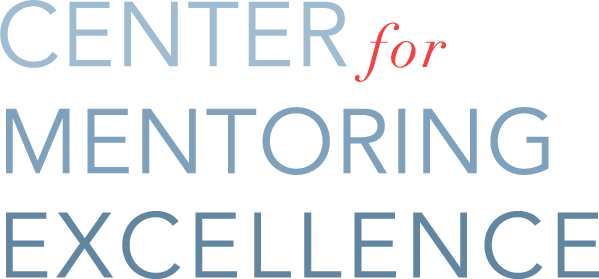by Center for Mentoring Excellence | May 30, 2014 | Mentoring Relationships
Whether you’re a mentor or a mentee, social media is a fantastic tool to amplify your voice and help you join communities. It provides you with the tools to reach out to those who inspire you to develop your career. Luckily, there are many social tools to help you along the way. Let’s look at the benefits of using social media as a mentor or mentee.
Finding a mentor
You could tweet a potential mentor on Twitter or send them a message on LinkedIn. But, convincing someone you’ve never met to be your mentor can be tricky. It’s critical that you know as much as possible about your prospective mentor before you reach out. Fortunately, researching is easy.
On Twitter, you can identify possible mentors by monitoring trending hashtags or creating lists of influential people. And, on LinkedIn, you can join industry-specific groups and build relationships with people you find inspiring.
Connecting with a mentor
Depending on the etiquette of the platform, reaching out to your potential mentor could be easy. On Twitter, it’s as simple as a follow. After you follow your potential mentor, make sure to add their handle to a list so that you can easily find and interact with their content.
On LinkedIn, it’s challenging. You don’t want your budding mentor to see you as spam, so be genuine and sincere. Reach out to them via InMail before you send an invitation to connect. Remember, LinkedIn is a professional platform — avoid the cat videos and silly memes.
Be yourself
When you interact on social media, be yourself. Being honest with potential mentors is the key to building rewarding professional relationships. In our digital world, it’s easy to connect and build professional relationships with people in any industry.
If you have questions, feel free to reach out!
by Center for Mentoring Excellence | Apr 5, 2014 | Group Mentoring
More and more businesses and organizations are turning to group mentoring to enhance the growth and development of their employees and accelerate organizational learning.
Why is there so much interest in group mentoring?
Group Mentoring. . . .
- Leverages the experience and expertise in an organization
- Provides an opportunity to build and strengthen relationships across, down and through the organization
- Promotes diversity and inclusion
- Offers mentors and mentees an opportunity to expand knowledge
- Exposes participants to multiple levels of expertise and organizational knowledge
- Creates shared understanding and alignment
- Maximizes time availability of qualified mentors and participants
- Creates a more efficient and scalable way to promote learning and development
- Complements and enhances one on one mentoring
Mentoring groups are structured in multiple ways. The possibilities are unlimited, from peer-to-peer, leader-led, virtual, nested configurations, to DIY groups . . . and the list goes on. The reasons you articulate for initiating group mentoring will drive the composition and structure of your mentoring groups.
Who will fill these seats in your organization? In which seat will you be sitting?
by Center for Mentoring Excellence | Mar 29, 2014 | Group Mentoring
Group mentoring offers some very rich opportunities for promoting group and individual learning.
While group mentoring multiplies the learning, it can only do so when members of the group intentionally and effectively work at strengthening relationships between and among themselves.
What are some of the most common pitfalls to avoid when it comes to group mentoring?
 1. Jumpstarting the process without first building trust. Too often group mentoring participants — particularly peer mentors — are so eager to get started that they jump right into mentoring without taking enough time to establish and build trust among themselves. In group mentoring, all mentoring partners must feel safe before they can feel comfortable enough to be open with one another and to experience significant learning.
1. Jumpstarting the process without first building trust. Too often group mentoring participants — particularly peer mentors — are so eager to get started that they jump right into mentoring without taking enough time to establish and build trust among themselves. In group mentoring, all mentoring partners must feel safe before they can feel comfortable enough to be open with one another and to experience significant learning.
 2. Failure to acknowledge difference. It is easy to assume that by virtue of being in a group, group members share common interests. While it is quite true that they may share some things in common, they are unique individuals and each brings who they are into the relationship. When members fail to understand their own and each other’s’ uniqueness, they miss out on the opportunity to learn from different perspectives.
2. Failure to acknowledge difference. It is easy to assume that by virtue of being in a group, group members share common interests. While it is quite true that they may share some things in common, they are unique individuals and each brings who they are into the relationship. When members fail to understand their own and each other’s’ uniqueness, they miss out on the opportunity to learn from different perspectives.
 3. Not fully committed to the process. When individuals are required to participate in group mentoring, they may fail to engage fully in the process. They may choose instead to sit back passively or withhold their opinions. Inevitably, it is the group that misses out. Lack of engagement impacts the learning of the entire group.
3. Not fully committed to the process. When individuals are required to participate in group mentoring, they may fail to engage fully in the process. They may choose instead to sit back passively or withhold their opinions. Inevitably, it is the group that misses out. Lack of engagement impacts the learning of the entire group.
 4. Failure to engage in conversation. Mentoring groups may sometimes say that they engage in “conversation.” What they are actually doing, though, is participating in a series of transactions or interactions. It is only when mentoring partners fully engage in conversation that deeper insights emerge. Conversation that demands collaborative engagement accelerates learning and takes group mentoring to a whole new level.
4. Failure to engage in conversation. Mentoring groups may sometimes say that they engage in “conversation.” What they are actually doing, though, is participating in a series of transactions or interactions. It is only when mentoring partners fully engage in conversation that deeper insights emerge. Conversation that demands collaborative engagement accelerates learning and takes group mentoring to a whole new level.
by Center for Mentoring Excellence | Mar 22, 2014 | Group Mentoring
There appears to be a groundswell of interest in group mentoring. New formats and forms of group mentoring are emerging all the time and in different industries and setting around the globe.
In group mentoring individuals either mentor each other or rely on one or more individuals to facilitate the learning of a group of mentees. Mentoring groups can be peer-led or facilitated by one or more experts who serve as group mentors.
10 Best Practices for Getting Group Mentoring Started
- Get to know the members of your group— not just their business titles but who they are as people.
- Clarify the purpose of the group. What is the purpose of your group and what do you want to accomplish?
- Decide on the process you are going to follow. Who will lead the group? What process will be used to make sure that participants receive what they need from the group?
- Define roles and responsibilities of group members so that each participant is clear about what is expected of them.
- Make everyone feel safe by putting confidentiality agreements in place.
- Talk about personal and group boundaries and how to address potential stumbling blocks, when and if they occur.
- Establish an agreed-upon set of ground rules. Will there be an agenda? When is the group going to meet? What happens if someone’s attendance is inconsistent or infrequent?
- Discuss each person’s learning style and how individual learning styles might affect the learning that goes on in the group.
- Agree on when and how to bring the group to positive closure. How will you know it is time for the group to come to closure?
- Establish an accountability process to help the group and its members stay on track. Is the group meeting its goals?
by Center for Mentoring Excellence | Mar 4, 2014 | Uncategorized
Without the presence of learning, mentoring doesn’t exist. It is the purpose, the process, and the product of a mentoring relationship.
Because learning is so central to mentoring, it is essential that mentors understand their mentees as learners. Mentors need to know how to engage and guide the mentee appropriately and to create a climate that supports learning. In addition, mentors must to be open to learning themselves. When you begin your relationship mentor and mentee should agree to the purpose.
What is it that the mentee wants to obtain from your meetings? Once you have figured out what you both are going to receive from the relationship, it is now time to plan the process. How frequently will we meet? What will our meetings consist of? What goals will the mentor set for the mentee? Finally, decided what you want to end product to be. Where do both mentor and mentee want to be after the relationship comes to a close? How will you measure your accomplishments?







